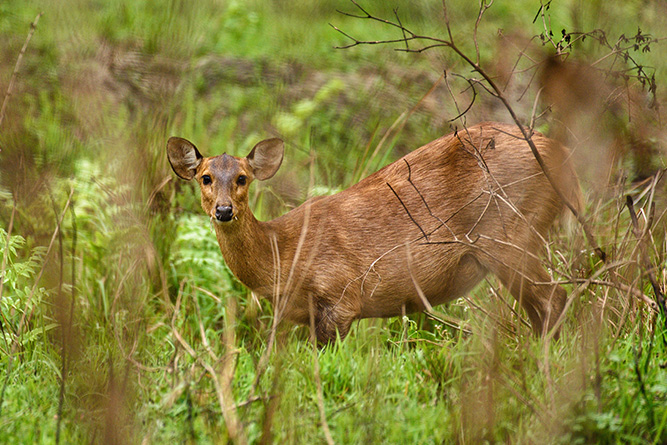The Indian Hog Deer, an intriguing member of the deer family, is known for its distinctive appearance and fascinating behavior. This species, native to South Asia, adds a touch of uniqueness to the region's wildlife.
Table of Contents
Species Data
- Class: Mammalia
- Order: Artiodactyla
- Family: Cervidae
- Scientific Name: Axis porcinus
- Life Span: 8 to 12 years
- Height: 65-70 cm (25-28 inches)
- Weight: 45-50 pounds (20-23 kilograms)
Description
Indian Hog Deer are relatively small in size compared to other deer species. They have a reddish-brown coat with distinctive white spots, which provide effective camouflage in their grassland habitats. Males (bucks) typically have simple, three-pronged antlers.
Appearance
Their name “Hog Deer” comes from their stocky build and somewhat pig-like appearance. They have short legs and a robust body, making them well-suited to their grassy and swampy habitats.
Behavior
Indian Hog Deer are primarily crepuscular, meaning they are most active during dawn and dusk. They are known for their agility and can run swiftly through their grassland homes. These deer are often seen in small groups or as solitary individuals.
Habitat
They thrive in grasslands, swamps, and riverine habitats across South Asia, including India, Nepal, and Bangladesh. These environments provide them with the ideal mix of food and cover.
Diet and Nutrition
Their diet mainly consists of grasses, aquatic plants, and shrubs. Their digestive system is adapted to efficiently process this plant-based diet.
Mating Habits
Indian Hog Deer typically mate during the monsoon season, with a gestation period of around 230 days. Female deer, known as does, give birth to one or two fawns, which they protect and nurture in the tall grass.
Mating Behavior
- Reproduction Season: Monsoon season
- Pregnancy Duration: Approximately 230 days
- Baby Carrying: Females hide their fawns in tall grass
- Independent Age: Fawns become independent at around 6 months
- Female Name: Doe
- Male Name: Buck
- Baby Name: Fawn
5 Fun Facts for Kids
- Indian Hog Deer are named for their hog-like appearance and behavior.
- They are excellent swimmers and can often be found in swampy areas.
- These deer are known for their distinctive barking alarm calls.
- Indian Hog Deer play a crucial role in maintaining grassland ecosystems.
- Their white spots provide excellent camouflage in tall grass, helping them avoid predators.


